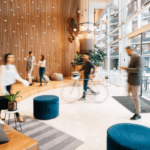
Leadership perspectives: Exploring new ways to work
Elisa Rönkä, Head of Digital Market Development, Europe at Siemens and Cisco Workplace Technology Strategist Mark Miller explore ways companies are approaching employee interactions with new workplace configurations.
“To address the rise of hybrid working, companies will need to transform how people work, where they work and how work gets done. Technology will play a critical role in this transformation, and become the foundation on which the modern workplace will be built.”
No one knows for sure how returning to work will, well, work. But those whose business it is to navigate uncharted waters have some ideas. Mark Miller has spent his 10+ year tenure at Cisco flexing with trends and disruptions to help companies create innovative workplaces through technology. Now, as we enter this new workplace reality, he’s focused on the intersection of workspace design, technology and culture. In this Q&A he talks with Siemens’ Head of Digital Market Development Europe, Elisa Rönkä, on how to balance these elements and plan for next-generation technology and hybrid work environments.
Q: What will the blend of physical and digital work look like? What challenges do you anticipate?
A: The “Great Work Experiment of 2020” has proven that, for the most part, knowledge workers can be productive working from home. Generally, we’ve been able to settle into this new normal. But as we look forward, a lot of us are unclear what to expect. For many, the relationship with the office has forever changed. We don’t miss the office; we miss being around our co-workers, our customers and our partners. With the realization that we can do a lot of our heads-down, concentration work at home, our workplaces will evolve, becoming community centers, places for people to collaborate, socialize and learn. In this new world a larger percentage of the workforce will become “hybrid workers”, having the ability to choose the most appropriate place to work on any given day, whether that be at home, in the office, a customer or co-working location. The hybrid work model will give autonomy to an increasing number of employees, and this will fundamentally change how companies plan, design and operate their workplace environments.
Q: And you think technology can do this? What role will it play?
A: Technology is going to play a huge role; in fact, I think it will become the foundation of the modern workplace. Technology will be the glue that connects physical and virtual work, and we are going to see some amazing innovations around how we enable and empower not only remote and hybrid workers, but those who return to the office full time. During the pandemic, robust collaboration tools like Cisco Webex, have kept us working. As we head into a post pandemic world, these solutions will play a critical role in keeping employees connected – not only to each other, but also to information and company resources. But it won’t stop there, with a more dispersed workforce companies will need to rethink how work gets done, and I think we will start to see collaboration capabilities more tightly integrated into workflows and business processes. To support the physical office’s transformation to community centers, workplace technology will need to evolve. Technology will be used to make the office more informative, intelligent and collaborative. Employees will want access to information, such as real-time floor and neighborhood occupancy, to help them make decisions on the best place to work. They will expect intelligent workplace services, such as booking and wayfinding, to help them more effectively utilize the assets of the workplace. Lastly, with the workplace becoming a destination for collaboration, there will be explosive growth in video conferencing, ensuring employees stay connected to their remote colleagues.
Q: With all this technology, how do we win over employees?
A: It starts by having a well-honed technology strategy that puts employees at the center of everything. Success will be defined by how we execute – too much technology is just as big a problem as too little technology. Our goal is to understand the biggest problems of each employee type and be precise on how we deliver solutions to solve their specific needs. We must be thoughtful on how we deliver technology, creating a single unified experience instead of multiple point solutions which require employees to navigate.
Q: If personalization is key, will there be more emphasis on smart building technology?
A: Yes. One of the biggest benefits of your home office is that it is totally personalized. If it’s too hot or too cold you can adjust the temperature; if it’s too dark you can turn on the lights or open the shades. I believe as employees return to the office there will be an expectation that they will have some level of control over their environment. Smart building technology will play an increasingly important role as workplaces transform, focusing on both sustainability and improving the “in office” experience for employees. We will see many new points of integration, where we start to harness the sensing powers of other technology within the workplace and integrate those with smart building solutions. This might include using the people counting data from video conferencing units, or from wireless access points in the ceiling, to lower the temperature based on occupancy of a specific room or neighborhood. It could be automatically adjusting the lighting in a room when an employee starts sharing content in a meeting or setting the height of a pre-booked shared desk to an employee’s personal preference once they badge into the building. More employees will be empowered to choose where they work, and the workplace is going to need to work harder to earn back their trust and respect. Creating work experiences that are better than employees have at home will be a critical factor in driving their return back to the office.
“We need to take the friction out of every workplace experience. Technology will be important, but we need to make employees the focus of everything we do.”
Q: We’re hearing from business leaders that they need more data to help them make decisions. What’s your opinion on the importance of analytics in the future workplace?
A: One of the biggest challenges business leaders are facing is that there is no historical perspective to guide us through this next wave of workplace transformation. The pandemic, and the ensuing rise of hybrid working, has real estate decision makers questioning how to plan space, it has IT leaders rethinking how to design more intelligent work environments and it has HR executives exploring ways to drive employee engagement with an increasingly dispersed workforce. The only way to manage this transformation is to measure everything, turn that data into information, and that information into insights and actions. The creation of the hybrid workplace is going to be as much about the journey as the destination. Every company will go through a series of course corrections in their journey, and those adjustments will be driven by data, information and insights. Putting these assets in the hands of decision makers to allow them to understand how employees, and workplace environments are performing, will define success.
Q: That’s what we’re working to achieve at Enlighted. Our solutions are used to inform and facilitate space configuration, workspace booking, collaboration and communication.
A: Exactly, and there are significant benefits to be gained. Solutions that keep employees informed and connected, and also allow them to more easily leverage workplace resources, will lead to dramatic increases in employee productivity, engagement and satisfaction. The analytics produced by Enlighted will help companies better understand the utilization of workplace environments, giving facilities leaders insights which allow them to optimize their real estate portfolios and design more effective workplace environments. Technology’s role in the hybrid workplace will be multi-faceted, and success will largely be defined by how companies bring all their technology architectures – including enterprise networking, security, collaboration, mobility, office productivity and workplace tools – into a single unified experience for their employees. I think this creates a unique opportunity for companies like Enlighted and Cisco to come together to enable this.
Flexible Spaces, an Enlighted solution, makes designing and managing your new workplace easy. The solution provides reservations, scheduling, communication, and space configuration tools to help you manage the workplace and gather valuable insights to help measure and meet both the needs of your employees and portfolio strategies.
The brightest way to operate, orchestrate, and optimize everyday spaces.


